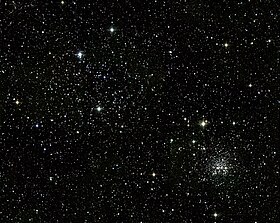
Messier 9 or M9 is a globular cluster in the constellation of Ophiuchus. It is positioned in the southern part of the constellation to the southwest of Eta Ophiuchi, and lies atop a dark cloud of dust designated Barnard 64. The cluster was discovered by French astronomer Charles Messier on June 3, 1764, who described it as a "nebula without stars". In 1783, English astronomer William Herschel was able to use his reflector to resolve individual stars within the cluster. He estimated the cluster to be 7–8′ in diameter with stars densely packed near the center.

Messier 35 or M35, also known as NGC 2168, is a relatively close open cluster of stars in the west of Gemini, at about the declination of the sun when the latter is at June solstice. It was discovered by Philippe Loys de Chéseaux around 1745 and independently discovered by John Bevis before 1750. It is scattered over part of the sky almost the size of the full moon and is 2,970 light-years away. The compact open cluster NGC 2158 lies directly southwest of it.
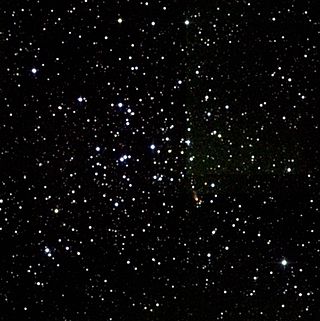
Messier 36 or M36, also known as NGC 1960, is an open cluster of stars in the somewhat northern Auriga constellation. It was discovered by Giovanni Batista Hodierna before 1654, who described it as a nebulous patch. The cluster was independently re-discovered by Guillaume Le Gentil in 1749, then Charles Messier observed it in 1764 and added it to his catalogue. It is about 1,330 pc away from Earth. The cluster is very similar to the Pleiades cluster (M45), and if as far away it would be of similar apparent magnitude.

Messier 38 or M38, also known as NGC 1912 or Starfish Cluster, is an open cluster of stars in the constellation of Auriga. It was discovered by Giovanni Batista Hodierna before 1654 and independently found by Le Gentil in 1749. The open clusters M36 and M37, also discovered by Hodierna, are often grouped together with M38. Distance is about 1.066 kpc (3,480 ly) away from Earth. The open cluster NGC 1907 lies nearby on the sky, but the two are most likely just experiencing a fly-by, having originated in different parts of the galaxy.

Messier 39 or M39, also known as NGC 7092, is an open cluster of stars in the constellation of Cygnus, positioned two degrees to the south of the star Pi Cygni and around 9° east-northeast of Deneb. The cluster was discovered by Guillaume Le Gentil in 1749, then Charles Messier added it to his catalogue in 1764. When observed in a small telescope at low power the cluster shows around two dozen members but is best observed with binoculars. It has a total integrated magnitude (brightness) of 5.5 and spans an angular diameter of 29 arcminutes – about the size of the full Moon. It is centered about 1,010 light-years away.
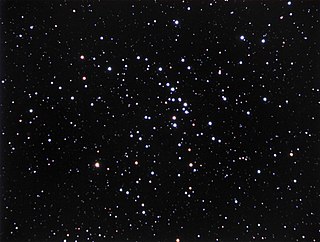
Messier 48 or M48, also known as NGC 2548, is an open cluster of stars in the equatorial constellation of Hydra. It sits near Hydra's westernmost limit with Monoceros, about 18° 34′ to the east and slightly south of Hydra's brightest star, Alphard. This grouping was discovered by Charles Messier in 1771, but there is no cluster precisely where Messier indicated; he made an error, as he did with M47. The value that he gave for the right ascension matches, however, his declination is off by five degrees. Credit for discovery is sometimes given instead to Caroline Herschel in 1783. Her nephew John Herschel described it as, "a superb cluster which fills the whole field; stars of 9th and 10th to the 13th magnitude – and none below, but the whole ground of the sky on which it stands is singularly dotted over with infinitely minute points".
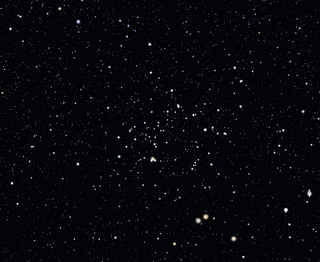
NGC 752 is an open cluster in the constellation Andromeda. The cluster was discovered by Caroline Herschel in 1783 and cataloged by her brother William Herschel in 1786, although an object that may have been NGC 752 was described by Giovanni Batista Hodierna before 1654.

NGC 188 is an open cluster in the constellation Cepheus. It was discovered by John Herschel in 1825. Unlike most open clusters that drift apart after a few million years because of the gravitational interaction of our Milky Way galaxy, NGC 188 lies far above the plane of the galaxy and is one of the most ancient of open clusters known, at approximately 6.8 billion years old.

NGC 381 is an open cluster of stars in the northern constellation of Cassiopeia, located at a distance of approximately 3,120 light-years from the Sun. Credit for the discovery of this cluster was given to Caroline Herschel by her brother William in 1787, although she may never have actually seen it.

NGC 2360 is an open cluster in the constellation Canis Major. It was discovered on 26 February 1783 by Caroline Herschel, who described it as a "beautiful cluster of pretty compressed stars near 1/2 degree in diameter". Her notes were overlooked until her brother William included the cluster in his 1786 catalogue of 1000 clusters and nebulae and acknowledged her as the discoverer. The cluster lies 3.5 degrees east of Gamma Canis Majoris and less than one degree northwest of the eclipsing binary star R Canis Majoris; it has a combined apparent magnitude of 7.2. It is 13 arc minutes in diameter. By the western edge of the cluster is the unrelated star, 5.5-magnitude HD 56405.
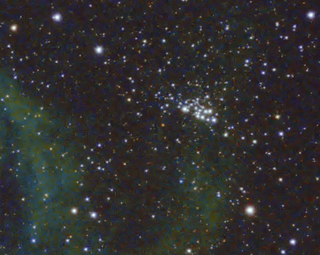
NGC 7510 is an open cluster of stars located around 11,400 light years away in the constellation Cepheus, near the border with Cassiopeia. At this distance, the light from the cluster has undergone extinction from interstellar gas and dust equal to E(B – V) = 0.90 ± 0.02 magnitude in the UBV photometric system. Its brightest member is a giant star with a stellar classification of B1.5 III. This cluster forms part of the Perseus Spiral Arm. It has a Trumpler class rating of II 2 m and is around 10 million years old.

NGC 5822 is an open cluster of stars in the southern constellation of Lupus. It was discovered by English Astronomer John Herschel on July 3, 1836, and lies close to another cluster, NGC 5823, which suggests there may be a physical association.

NGC 265 is an open cluster of stars in the southern constellation of Tucana. It is located in the Small Magellanic Cloud, a nearby dwarf galaxy. The cluster was discovered by English astronomer John Herschel on April 11, 1834. J. L. E. Dreyer described it as, "faint, pretty small, round", and added it as the 265th entry in his New General Catalogue.

NGC 6752 is a globular cluster in the constellation Pavo. It is the fourth-brightest globular cluster in the sky, after Omega Centauri, 47 Tucanae and Messier 22, respectively. It is best seen from June to October in the Southern Hemisphere.

NGC 2506 is a mildly-elongated open cluster of stars in the equatorial constellation of Monoceros, located at a distance of 12.7 kly from the Sun near the Galactic anti-center. It was discovered by William Herschel in 1791. The cluster lies around 10,000 ly from the Galactic Center and about 1,600 ly above the Galactic plane. It is of intermediate age, estimated at around two billion years. The cluster has an angular radius of 12′ and a core radius of 4.8′.

NGC 637 is an open cluster of stars in the northern constellation of Cassiopeia, positioned about 1.5° to the WNW of the star Epsilon Cassiopeiae. The cluster was discovered on 9 November 1787 by German-born English astronomer William Herschel. It is located in the Perseus Arm of the Milky Way, at a distance of approximately 7.045 kilolight-years from the Sun. The cluster is small but compact, and is readily visible in a small telescope.

NGC 1817 is an open cluster of stars in the constellation Taurus. It was discovered by English astronomer William Herschel in February 1784. With an apparent magnitude of 7.7 and spanning 9.3 arc minutes across the sky, it is separated from the NGC 1807 cluster by just 26 arc minutes. Indeed, the two may actually be parts of a single extended cluster.

NGC 1245 is an open cluster in the constellation Perseus. It was discovered by William Herschel in 11 December 1786. It is located 3° southwest of alpha Persei and can be spotted with 10x50 binoculars. The cluster is nearly 1 billion years old. NGC 1245 has about 200 members the brightest of which are of 12th magnitude. The cluster shows evidence of mass segregation and it is possible that it has lost its lower mass members. Lying at a distance of 3kpc, the cluster is estimated to be 27 light years across.

NGC 6939 is an open cluster in the constellation Cepheus. It was discovered by William Herschel in 1798. The cluster lies 2/3° northwest from the spiral galaxy NGC 6946. The cluster lies approximately 4,000 light years away and it is over a billion years old.
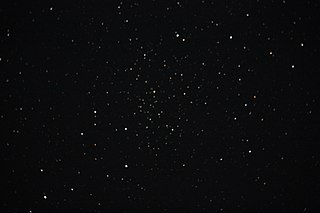
NGC 6940 is an open cluster in the constellation Vulpecula. It was discovered by William Herschel in 1784. The cluster is nearly a billion years old and it is located 2,500 light years away. It is considered the finest open cluster in the constellation.
